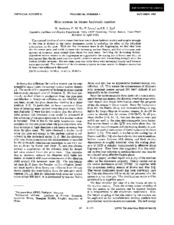| dc.creator | Asakawa, M. | |
| dc.creator | Ko, Che Ming | |
| dc.creator | Levai, P. | |
| dc.creator | Qiu, X. J. | |
| dc.date.accessioned | 2011-09-13T21:26:37Z | |
| dc.date.available | 2011-09-13T21:26:37Z | |
| dc.date.issued | 1992 | |
| dc.identifier.citation | M. Asakawa, Che Ming Ko, P. Levai and X. J. Qiu. Phys.Rev.C 46 R1159-R1162 1992. "Copyright (1992) by the American Physical Society." | en |
| dc.identifier.uri | http://dx.doi.org/10.1103/PhysRevC.46.R1159 | |
| dc.identifier.uri | https://hdl.handle.net/1969.1/126829 | |
| dc.description | Journals published by the American Physical Society can be found at http://publish.aps.org/ | en |
| dc.description.abstract | The spectral function of a rho meson that is at rest in dense hadronic matter and couples strongly to the pion is studied in the vector dominance model by including the effect of the delta-hole polarization on the pion. With the free rho-meson mass in the Lagrangian, we find that both the rho-meson peak and width increase with increasing nuclear density, and that a low-mass peak appears at invariant mass around three times the pion mass. Including the decreasing density-dependent hadron masses in the Lagrangian as suggested by the scaling law of Brown and Rho, we find instead that the rho peak moves to smaller invariant masses with diminishing strength when the nuclear density increases. The low-mass peak also shifts down with increasing density and becomes more pronounced. The relevance of the rho-meson property in dense matter to dilepton production in heavy-ion collisions is discussed. | en |
| dc.language.iso | en | |
| dc.publisher | American Physical Society | |
| dc.subject | HEAVY-ION COLLISIONS | en |
| dc.subject | NUCLEAR-MATTER | en |
| dc.subject | DIELECTRON PRODUCTION | en |
| dc.subject | DILEPTON | en |
| dc.subject | PRODUCTION | en |
| dc.subject | TEMPERATURE | en |
| dc.subject | Physics | en |
| dc.title | Rho Meson in Dense Hadronic Matter | en |
| dc.type | Article | en |
| local.department | Physics and Astronomy | en |


